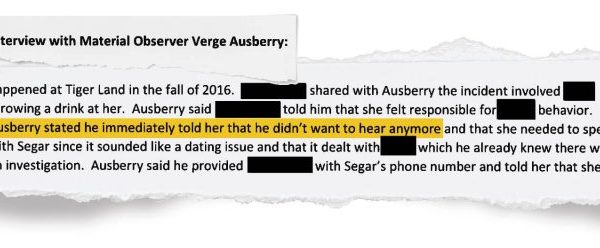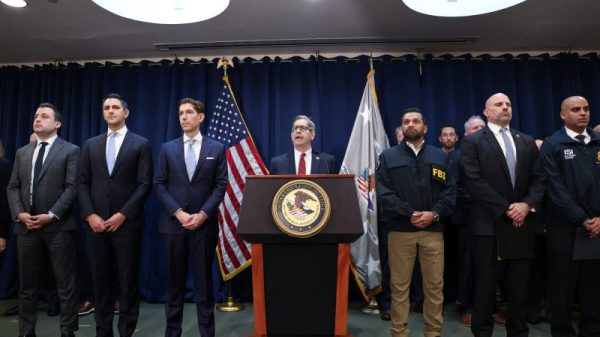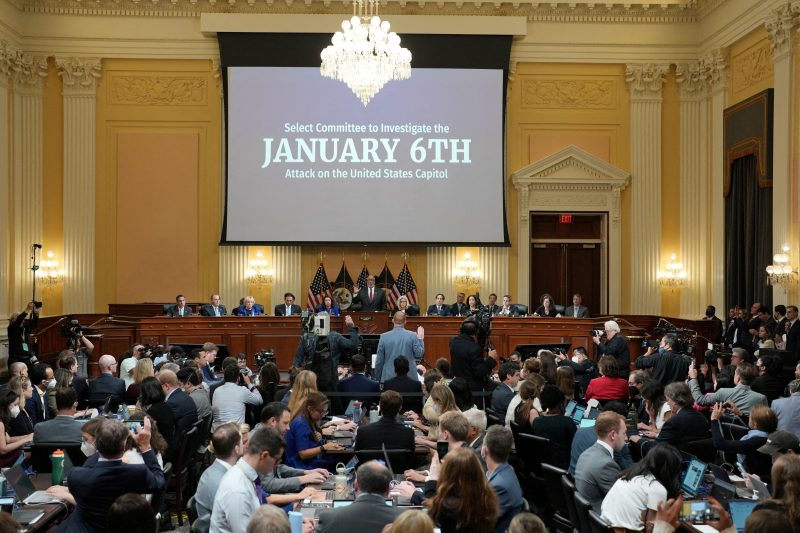The House committee investigating the Jan. 6, 2021, attack on the U.S. Capitol on Thursday recommended that Congress consider barring former president Donald Trump from ever holding public office again as a result of his role inciting that day’s insurrection.
The committee issued its final, 800-plus-page report late Thursday, along with a list of 11 recommendations to prevent an event such as the attack on the U.S. Capitol from occurring again.
Among the proposals: reform of the Electoral Count Act to clarify that a vice president has no authority to reject electoral slates submitted by the states; wholesale expansion of federal law enforcement agencies’ scrutiny of extremist groups, including white nationalists and violent anti-government groups; and designation of the counting of electoral votes by Congress every four years as a “National Special Security Event,” like inaugurals and State of the Union addresses.
The recommendations came as the committee released its final report, concluding 18 months of work with a carefully footnoted document intended to cement its findings that Trump’s conduct following the 2020 presidential election was to blame for the unprecedented assault on Congress.
Over eight chapters, the committee wove together evidence drawn from thousands of documents and more than 1,000 witness interviews to argue that Trump embarked on an orchestrated plan to remain in office despite his election loss, pressuring state officials, the Justice Department and his own vice president to help him. Ultimately, the committee argues, he inspired his supporters to commit violence in his name.
“Our country has come too far to allow a defeated President to turn himself into a successful tyrant by upending our democratic institutions, fomenting violence, and, as I saw it, opening the door to those in our country whose hatred and bigotry threaten equality and justice for all Americans,” the panel’s chairman, Rep. Bennie G. Thompson (D-Miss.), said in the forward to the report.
What will come of the recommendations is another matter. The committee is preparing to disband within days as the Republicans take over the House, with four of the committee’s nine members — including its two Republicans — not returning in the new Congress.
The new GOP majority has signaled that it intends to scour the work of the committee for flaws and missteps. Although some recommendations may be implemented — including reform of the Electoral Count Act, which is being taken up during this month’s lame-duck session — Republicans are likely to block any congressional action required to implement many of the committee’s other recommendations.
Trump quickly issued a statement on the Truth Social website seeking to discredit the committee’s work — and falsely blaming House Speaker Nancy Pelosi (D-Calif.) for the violence on Jan. 6.
“The highly partisan Unselect Committee Report purposely fails to mention the failure of Pelosi to heed my recommendation for troops to be used in D.C., show the “Peacefully and Patrioticly” words I used, or study the reason for the protest, Election Fraud,” the former president wrote. “WITCH HUNT!”
The committee had already presented the contours of its case, as well as many of the investigation’s most striking details, over eight public hearings conducted in June and July. On Monday, the committee voted to refer Trump to the Justice Department for criminal investigation, a legally nonbinding step intended to offer the committee’s recommendation for how Trump should be held accountable for his actions.
All that was left this week was the publication of a detailed written report fleshing out the minutia of the committee’s work, along with a long list of transcripts of some of the committee’s most revelatory interviews.
The committee’s recommendations largely deal with how best to hold Trump and his allies accountable for the Jan. 6 attack, reflecting the report’s broader focus on the former president’s conduct. The report notes that the 14th Amendment allows barring people from office who “engaged in an insurrection” or gave “aid and comfort to the enemies of the Constitution.”
The recommendations touch only briefly on other issues, including a passing reference to improved oversight of the U.S. Capitol Police. The report also recommended enhancing criminal penalties for those who threaten election workers — a phenomenon that exploded amid Trump’s false claims that the 2020 election was stolen.
The report took a hard line against anyone who participated in the insurrection or supported Trump’s efforts to overturn the 2020 presidential result. Among the recommendations was a prescription for the Justice Department to bar its attorneys from participating in campaign-related activities “aimed at subverting the rule of law and overturning a lawful election.” That recommendation seemed aimed squarely at Jeffrey Clark, a former Justice Department assistant attorney general who worked with Trump to keep him in office.
The committee’s recommendation to limit the vice president’s role in making presidential results official stems from Trump’s efforts to persuade Mike Pence to block the counting of electoral college votes on Jan. 6, 2021. Pence refused those entreaties.
According to the report, Trump’s advisers repeatedly tried to talk him out of marching to the Capitol ahead of Jan. 6. Senior adviser Max Miller shot it down “immediately” out of safety concerns, the report says. Trump floated the idea of having a phalanx of National Guard troops protect him on the walk, but that too was shot down.
“Just glad we killed the national guard and a procession,” Miller wrote in a text, according to the report. That did not deter the former president, however; he would continue to try to go even that day, leading to a heated confrontation with his Secret Service detail.
The report also documented in vivid detail Trump’s propensity to ally with fringe figures. Alex Jones, the right-wing conspiracist who has claimed that the 2012 Sandy Hook, Conn., massacre of 26 schoolchildren and educators was a hoax, apparently believed he would have a leadership role on Jan. 6.
That day, he texted GOP fundraiser Caroline Wren about “when he should leave the Ellipse and begin the march,” according to the report. Jones has publicly claimed that “the White House told me three days before, we are going to have you lead the March,” the report says.
And the report accused Trump of contributing to the planning of the Jan. 6 march well ahead of time. The former president’s advisers first discussed a march on the U.S. Capitol on Dec. 27, according to the findings of the select committee, more than a week before his supporters did just that.
A Trump aide and lead rally organizer, Justin Caporale, wrote in a text that day that the president’s speech on Jan. 6 may be followed by a “call to action to march to the [C]apitol and make noise.”
“This is the earliest indication uncovered by the Select Committee that the president planned to call on his supporters to march on the U.S. Capitol,” the report said.
On Jan. 2, rally organizer Katrina Pierson said she was told by White House Chief of Staff Mark Meadows that the president would call on his supporters to march. The committee found several other messages supporting its contention that the march was not spontaneous or grass roots, but discussed extensively within the former president’s orbit for many days.
The committee on Wednesday began releasing transcripts from witness interviews, the raw material of the investigation that was used to build the slickly produced summer hearings and the voluminous new report. Republicans will now likely pore through the original source material, looking for places where the committee failed to disclose potentially exculpatory evidence or moments when witness memories differed from the committee’s narrative in important ways.
The final weeks of the committee’s work had been marked by significant disputes behind the scenes about whether the report should be focused exclusively on Trump’s actions. Vice Chair Liz Cheney (R-Wyo.) had argued that straying from the former president’s culpability would muddy the public argument that he is unfit for office, just as Trump launches his bid for reelection.
Other committee members and staff, notably retiring Florida Democrat Stephanie Murphy, argued the committee’s mandate had been broader than Trump and the panel would undercut its credibility by excluding details it had gathered about the failure of security agencies to prevent the attack.
Ultimately, the report released Thursday represented something of a compromise. A 30-page appendix was devoted to tracking the government’s response to copious warnings of possible violence received by the FBI, the Department of Homeland Security and other security agencies in the weeks before Jan. 6 — red flags that were not heeded in preparing a robust defense of the Capitol that day.
“Although some of that intelligence was fragmentary, it should have been sufficient to warrant far more vigorous preparations for the security of the joint session. The failure to sufficiently share and act upon that intelligence jeopardized the lives of the police officers defending the Capitol and everyone in it,” the committee wrote.
But the committee placed much of the blame for the government’s poor preparation on Trump as well, arguing there was sufficient intelligence to have caused Trump to cancel his speech and that security agencies had failed to ancitipate how the mob of thousands would be supercharged by his combative speech on the Ellipse that morning.
It was one of four appendixes the committee included that covered material that bore less directly on Trump’s personal culpability. Those pieces of the report covered the delay in calling out the D.C. National Guard, how Trump’s election lies were used to raise money and the role of foreign interference in the circumstances surrounding Jan. 6.
The report described confusion over which federal agency had agreed to be primarily in charge that day and over whether there had been adequate consideration given to calling out the D.C. National Guard.
The committee’s investigation into social media was ultimately cut from the final report, according to people familiar with the investigation. The cut was a major blow to staffers who spent months scrutinizing the critical role social media played in spreading lies that fomented the Jan. 6 attack.
The committee’s final act was marked by confusion and delays. Staff had promised to release the lengthy document multiple times during the final preholiday week, with its publication only coming at nearly 10 p.m. on the East Coast, three days before Christmas.
One sign that the committee’s final report was far more rushed and chaotic than its carefully orchestrated hearings: The date of the report, prominently displayed on its cover, is “December 00, 2022.” The committee initially announced that the report would be released Wednesday. On Thursday morning, Pelosi said it would be released Thursday. The committee made that deadline with just hours to spare.
Mariana Alfaro, Aaron Blake, Emma Brown, Josh Dawsey, Aaron Davis, Camila DeChalus, Meryl Kornfield, Carol D. Leonnig, Patrick Marley, Kyle Melnick, Kyle Rempfer, Yvonne Wingett Sanchez, Aaron Schaffer, Isaac Stanley-Becker, Perry Stein, Dylan Wells, Azi Paybarah, Hannah Allam and John Wagner contributed to this report.



























